How to Build a Sauna That Meets Your Specific Needs and Budget
Building your own sauna is a rewarding project that allows you to create a personalized sanctuary tailored to your unique needs, preferences, and budget. Whether you're seeking relaxation, potential sauna health benefits, or a space to socialize, a well-designed sauna can provide a multitude of benefits.
In this comprehensive guide, we'll walk you through the essential steps of planning, designing, and constructing your very own sauna.
By the end of this article, you'll have the knowledge and confidence to create a sauna that meets your unique requirements and provides a tranquil escape for years to come.
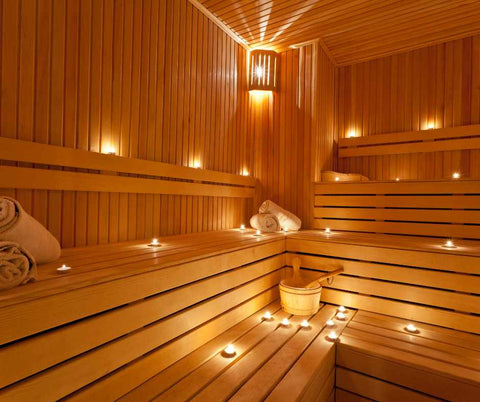
Saunas: What You Need to Know
Building a sauna tailored to your preferences and budget begins with a solid understanding of sauna basics.
History and Types of Saunas
The tradition of sauna bathing dates back thousands of years, with its sauna history deeply embedded in Nordic cultures, particularly in Finland. Originally, saunas were dug into the earth and used as dwellings in winter. The modern sauna, as we know it, evolved from these early versions to become a place for relaxation, hygiene, and socializing.
Here are the several types of saunas to consider, each offering a unique experience:
Traditional Finnish Saunas
Traditional saunas use a wood-burning stove to heat stones. Then it radiates heat into the sauna room. Water is thrown onto the hot stones to produce steam, increasing the humidity and intensifying the heat sensation.
Electric Saunas
Electric saunas are similar to Finnish saunas in design but use an electric heater instead of a wood stove. They are easier to install in residential settings due to their straightforward electrical requirements.
Infrared Saunas
Infrared saunas use infrared lamps to warm your body directly instead of heating the surrounding air. This type of sauna operates at a lower temperature, making it a suitable option for those who might find traditional saunas too intense.
Steam Rooms (Turkish Saunas)
Different from dry saunas, steam rooms maintain 100% humidity with a much lower sauna temperature, providing a different kind of therapeutic experience.
Potential Benefits of a Sauna

Saunas are not only about indulgence; they offer numerous potential health benefits:
Detoxification: Sweating is one of the body's natural ways to eliminate toxins.
Relaxation and Stress Relief: The heat from saunas helps relax muscles, soothe aches and pains in muscles and joints, and relieve stress.
Improved Circulation: The heat causes your heart rate to increase, similar to the effects of moderate exercise.
Skin Rejuvenation: Sweating opens up pores and helps cleanse the outer skin layer.
Respiratory Benefits: The warm, humid air can help open airways, improving breathing and alleviating some respiratory conditions.
Considerations Before Building Your Indoor Sauna or Outdoor Sauna
Before you pick up a hammer, there are several factors to ponder to ensure your sauna project is successful:
-
Location: Indoor vs. outdoor? You need to decide where your sauna fits best based on your space, privacy, and accessibility.
-
Size and Capacity: How many people will use the sauna at once? This will determine the dimensions of your sauna.
-
Type of Sauna: Based on your personal health goals, space, and budget, decide whether a traditional, infrared, or steam sauna is right for you.
-
Ventilation: Proper air circulation is imperative for safety and comfort. Ensure your design includes an efficient ventilation system.
-
Materials: The choice of wood is significant not just for aesthetics but also for durability and resistance to moisture and heat.
-
Electrical Requirements: If you opt for an electric or infrared sauna, you'll need to ensure your electrical system can handle the additional load.
RELATED TO: How to Use a Sauna
Planning Your Sauna Build
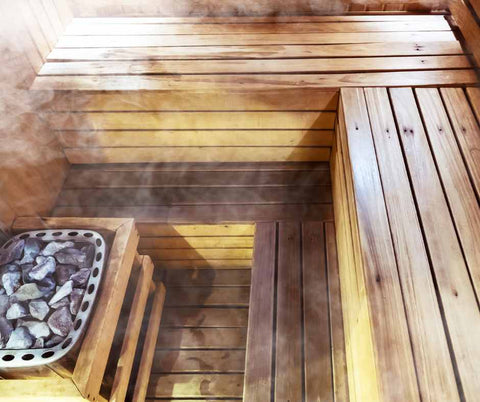
Building your sauna involves thorough planning and consideration to ensure that the final result aligns with your needs, preferences, and budget constraints.
Determining Your Sauna Needs
It's important to assess your specific sauna needs to tailor the design accordingly. Consider the following aspects:
-
Purpose and Use: Reflect on the primary purpose of your sauna. Is it for relaxation, health benefits, socializing, or a combination of these? The intended use will influence the size, type, and features of your sauna.
-
Size and Capacity: Determine how many people will typically use the sauna at one time. A personal sauna might be compact, accommodating 1-2 people, whereas a family or social sauna will need to be larger, perhaps fitting 4-6 individuals comfortably. Remember, the larger the sauna, the more it will cost to build and operate.
-
Indoor vs. Outdoor: Decide whether you prefer an indoor sauna space that's easily accessible from within your home or an outdoor sauna that can offer a more authentic experience and scenic views. Indoor saunas are more protected from the elements, but outdoor saunas can provide a more immersive experience in nature.
-
Sauna Type: Based on your preferences for dry heat, steam, or infrared therapy, choose the sauna type that best suits your lifestyle and health goals. Each type has different installation and operational requirements.
Setting a Budget
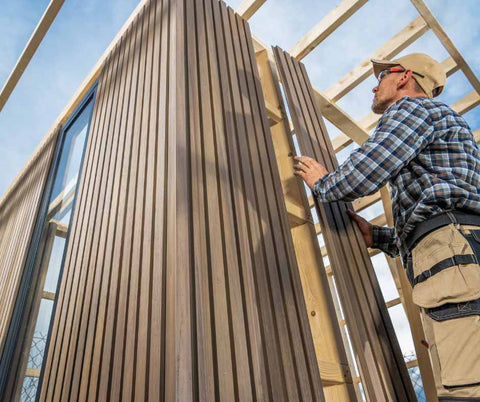
Your budget is an important factor in the planning process, influencing everything from the size and materials to the type of heater you can afford.
Here's how to set a realistic budget:
-
Initial Costs: These include construction materials, sauna heater, sauna benches, wall insulation, and any professional services you might need. Prices can vary widely based on the quality and type of materials, as well as the sauna size and type.
-
Operational Costs: Don't forget to account for the ongoing costs of running your sauna, including electricity or wood, maintenance, and potential repairs. Infrared saunas tend to be more energy-efficient compared to traditional electric or wood-burning saunas.
-
Cost-Saving Tips: Look for ways to save without compromising quality. This might include doing some of the work yourself, sourcing materials on sale or from sustainable sources, and choosing a sauna kit that you can assemble at home.
-
Unexpected Expenses: Always include a buffer in your budget for unforeseen costs. A general rule of thumb is to add an additional 10-20% to your estimated budget to cover any unexpected expenses that may arise during the construction process.
By meticulously planning and considering each aspect of your sauna build, you can ensure that the project stays within your budget while meeting all your specific needs and preferences.
Choosing the Right Materials and Tools
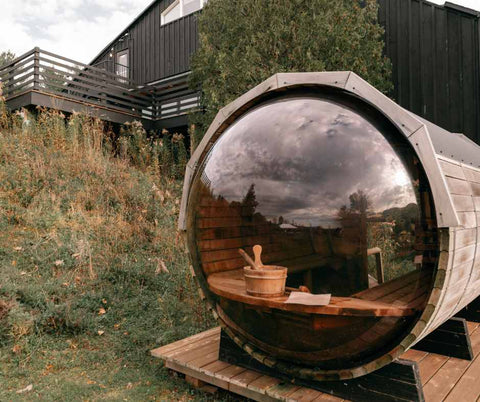
Selecting appropriate materials and having the right tools at hand are important steps in ensuring the durability, functionality, and aesthetics of your sauna. This section will guide you through the best materials for building a sauna and the essential tools required for the construction process.
Sauna Materials 101
The choice of materials is not just about aesthetics; it significantly affects the sauna's performance, longevity, and safety.
Here are the key materials to consider:
-
Wood: The most traditional and popular material for saunas, wood types like Cedar, Hemlock, and Nordic Spruce are favored for their resistance to moisture, decay, and their ability to withstand the high heat of a sauna without warping or emitting harmful substances. Cedar, especially, is known for its aromatic properties and natural resistance to mold and bacteria.
-
Insulation: Proper insulation is crucial for keeping the heat in and ensuring your sauna heats up efficiently. Fiberglass insulation is commonly used in interior walls and ceilings, covered by a vapor barrier to prevent moisture from penetrating the structure.
-
Sauna Heater: The heart of your sauna, the heater can be electric, wood-burning, or infrared, depending on your sauna type. Each heater type has its considerations regarding installation, efficiency, and the kind of heat it produces.
-
Sauna Rocks: If you're opting for a traditional sauna, you'll need sauna stones that withstand high temperatures and retain heat well. These are placed in or around the heater, and when water is poured over them, they help generate steam.
-
Benches and Flooring: Benches should be made from a durable, comfortable wood that doesn't get too hot, such as Cedar or Basswood. For flooring, consider materials that are slip-resistant and can handle moisture well, like tile or sealed concrete.
Essential Tools and Equipment
Having the right tools for the job can make your sauna-building project more manageable and more enjoyable. Here's a basic list of tools you'll need:
-
Measuring Tape and Level: Precision is key in building a home sauna, so a reliable measuring tape and level are indispensable.
-
Saw: Depending on the type of sauna and materials, you may need different saws. A circular saw is great for cutting boards to size, while a jigsaw can handle more intricate cuts.
-
Hammer and Nails/Screw Gun and Screws: For assembling the wooden components of your sauna, you'll need a hammer and nails or a screw gun and screws. The choice depends on your preference and the materials you're using.
-
Drill: A drill is necessary for pre-drilling holes for screws, especially when working with hardwoods that might split.
-
Staple Gun: This is used for attaching the vapor barrier to the walls and ceiling.
-
Carpenter's Square and Pencil: For marking and ensuring your cuts are perfectly square.
-
Protective Gear: Don't forget safety glasses, gloves, and ear protection, especially when using power tools.
While some specialized tools might be needed based on the specific requirements of your sauna build, this list covers the essentials that will be used throughout the construction process.
The Construction Process
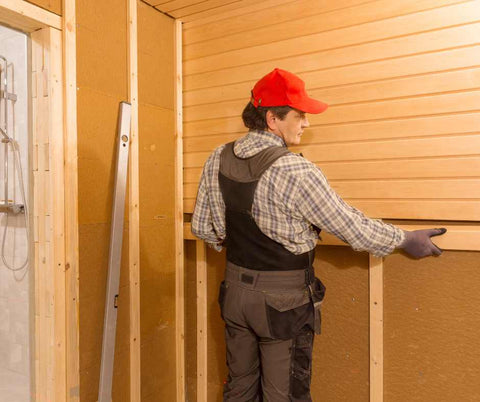
Building an indoor home sauna is a rewarding project that requires careful planning and execution. This section will walk you through the critical steps of the construction process, from preparing the site to adding the finishing touches to your sauna.
Preparation and Foundation
The foundation is the first step in your sauna-building journey. Here’s how to ensure it's done right:
-
Site Selection: Choose a level, well-drained area for your sauna. If building indoors, ensure the room can handle the moisture and heat.
-
Foundation Type: For outdoor saunas, options include concrete slabs, pavers, or a wooden deck. Indoor saunas might only need waterproof flooring and adequate drainage.
-
Ventilation Plan: Proper ventilation is crucial for air circulation and maintaining air quality. Plan for an intake vent near the floor and an outlet vent near the ceiling, ideally opposite each other.
Building the Structure
With a solid foundation in place, it’s time to construct the sauna’s frame and walls:
-
Framing: Start by constructing a sturdy frame using your chosen wood. Ensure it’s level and square.
-
Insulation and Vapor Barrier: Install insulation between the framing studs, then cover it with a vapor barrier to prevent moisture from penetrating the walls and ceiling. To enhance the efficiency of your sauna and ensure its longevity, incorporating an aluminum vapor barrier behind the interior wood panels can effectively reflect heat back into the sauna and prevent moisture from seeping into the structure.
-
Walls and Ceiling: Attach the wood panels to the frame, starting from the bottom and working your way up. When constructing the ceiling of your sauna, it's essential to ensure that the ceiling joists are properly spaced and secured to support the weight of the ceiling materials and any additional fixtures like lighting. The ceiling is typically done last.
-
Door Installation: Install a pre-made sauna door or build one from your wood materials. Ensure it seals well to keep heat in.
Installing the Sauna Heater
Choosing the right heater and installing it correctly is critical for your sauna's performance:
-
Heater Type: Decide between electric, wood-burning, or infrared based on your sauna type and personal preference. If you're considering a gas heater for your sauna, it's crucial to plan the route and installation of the gas pipe early in the design process to ensure compliance with safety regulations and efficient operation.
-
Positioning: Place the heater according to the manufacturer’s instructions, ensuring it’s properly vented (for wood-burning) and has the correct electrical connections (for electric heaters).
-
Safety Clearances: Maintain the recommended clearances between the heater, benches, and walls to prevent fire hazards.
Finishing Touches
The final steps will transform your custom sauna from a construction project into a relaxing retreat:
-
Benches: Install benches at different heights to offer varying temperature zones within the sauna. Ensure they are securely fastened and can support the weight of multiple users.
-
Lighting: Install low-voltage, moisture-resistant lighting to enhance the ambiance without compromising safety.
-
Accessories: Consider adding a thermometer, hygrometer, and hourglass to monitor the sauna's temperature, humidity, and sauna session duration. A bucket and ladle are essential for a traditional sauna experience, allowing you to pour water over the hot stones to generate steam.
-
Many sauna enthusiasts also consider adding a hot tub to their relaxation space, creating a versatile wellness area that combines the dry heat of the sauna with the soothing hydrotherapy of a hot tub.
Maintaining Your Sauna

Regular maintenance keeps your home sauna clean, safe, and enjoyable to use.
Here are some tips on how to clean your sauna:
-
Regular Cleaning: After use, wipe down benches and surfaces to remove sweat and moisture. Use mild, non-abrasive cleaners specifically designed for saunas to clean the wood without damaging it.
-
Wood Care: Periodically sand down benches and walking surfaces to remove stains and maintain a smooth surface. Treat the wood with natural oils designed for sauna use to protect and preserve it.
-
Ventilation Check: Regularly inspect and clean the ventilation system to ensure it's free from obstructions and functioning correctly.
-
Heater Maintenance: For electric heaters, check and replace any worn-out elements or parts as per the manufacturer's guidelines. For wood-burning stoves, clean the chimney and firebox regularly to prevent soot buildup and ensure efficient operation.
-
Inspect and Repair: Periodically inspect your sauna for signs of wear and tear, especially the structural elements, door, and seals. Repair or replace any damaged parts promptly to prevent further damage.

In Summary
Building a custom sauna that meets your specific needs and budget is an attainable goal with careful planning, the right materials, and attention to detail throughout the construction process.
From understanding the various types of saunas and their benefits to selecting materials, constructing the home sauna, and ensuring it is safe and well-maintained, each step plays a crucial role in creating a space that enhances your well-being and relaxation.
